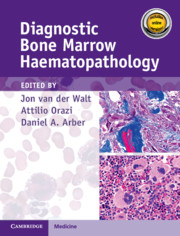Book contents
- Diagnostic Bone Marrow Haematopathology
- Diagnostic Bone Marrow Haematopathology
- Copyright page
- Contents
- Contributors
- Preface
- Acknowledgements
- Chapter 1 The Bone Marrow Biopsy
- Chapter 2 The Normal Bone Marrow
- Chapter 3 Necrosis, Stromal Changes and Artefacts
- Chapter 4 Aplasia
- Chapter 5 Hyperplasia
- Chapter 6 Infective, Granulomatous and Benign Histiocytic Disorders
- Chapter 7 Malignant Disorders of the Histiocytic/Dendritic Lineage
- Chapter 8 Myelodysplastic Syndromes
- Chapter 9 Acute Myeloid Leukaemia
- Chapter 10 Myeloproliferative Neoplasms
- Chapter 11 Myelodysplastic/Myeloproliferative Neoplasms
- Chapter 12 Systemic Mastocytosis
- Chapter 13 Myeloid and Lymphoid Neoplasms Associated with Eosinophilia
- Chapter 14 Precursor Lymphoid Neoplasms
- Chapter 15 Mature Lymphoid Neoplasms
- Chapter 16 Plasma Cell Neoplasia
- Chapter 17 Metastatic Lesions
- Chapter 18 Bone Marrow Changes Following Therapy and Immunosuppression
- Chapter 19 Immunohistochemistry and Flow Cytometry in Bone Marrow Haematopathology
- Chapter 20 Molecular Diagnostics in Bone Marrow Haematopathology
- Index
- References
Chapter 14 - Precursor Lymphoid Neoplasms
Published online by Cambridge University Press: 12 November 2020
- Diagnostic Bone Marrow Haematopathology
- Diagnostic Bone Marrow Haematopathology
- Copyright page
- Contents
- Contributors
- Preface
- Acknowledgements
- Chapter 1 The Bone Marrow Biopsy
- Chapter 2 The Normal Bone Marrow
- Chapter 3 Necrosis, Stromal Changes and Artefacts
- Chapter 4 Aplasia
- Chapter 5 Hyperplasia
- Chapter 6 Infective, Granulomatous and Benign Histiocytic Disorders
- Chapter 7 Malignant Disorders of the Histiocytic/Dendritic Lineage
- Chapter 8 Myelodysplastic Syndromes
- Chapter 9 Acute Myeloid Leukaemia
- Chapter 10 Myeloproliferative Neoplasms
- Chapter 11 Myelodysplastic/Myeloproliferative Neoplasms
- Chapter 12 Systemic Mastocytosis
- Chapter 13 Myeloid and Lymphoid Neoplasms Associated with Eosinophilia
- Chapter 14 Precursor Lymphoid Neoplasms
- Chapter 15 Mature Lymphoid Neoplasms
- Chapter 16 Plasma Cell Neoplasia
- Chapter 17 Metastatic Lesions
- Chapter 18 Bone Marrow Changes Following Therapy and Immunosuppression
- Chapter 19 Immunohistochemistry and Flow Cytometry in Bone Marrow Haematopathology
- Chapter 20 Molecular Diagnostics in Bone Marrow Haematopathology
- Index
- References
Summary
Neoplasms arising from precursor lymphoid cells committed to the B-cell or T-cell lineage can present primarily in the bone marrow (BM), blood (i.e. leukaemic presentation) or at extramedullary tissue sites (i.e. lymphomatous presentation) (Table 14.1). Hence, these neoplasms are appropriately termed as B- or T-lymphoblastic leukaemia/lymphoma [1, 2].
- Type
- Chapter
- Information
- Diagnostic Bone Marrow Haematopathology , pp. 231 - 244Publisher: Cambridge University PressPrint publication year: 2021



